The story begins at Loma Linda
[California]
back in 1941 where elder J. L. Shaw, former [Seventh-day Adventist]
General Conference Treasurer, was a patient, and I, a student at La Sierra College, was his
night nurse. One night about midnight Elder Shaw couldn't sleep. 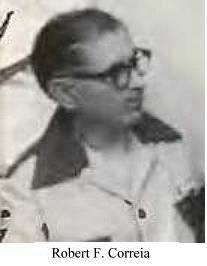 Something seemed to
disturb him. When asked why he was so restless he
replied: "I'm very worried. For many years we have been preaching that
the Pope has the title Vicarius Filii Dei which adds up to 666 and now
we have been challenged officially by the Catholic church to prove this
allegation by producing not some Protestant testimony; but reliable
Catholic sources."
Something seemed to
disturb him. When asked why he was so restless he
replied: "I'm very worried. For many years we have been preaching that
the Pope has the title Vicarius Filii Dei which adds up to 666 and now
we have been challenged officially by the Catholic church to prove this
allegation by producing not some Protestant testimony; but reliable
Catholic sources."
Then Elder Shaw told how it all started with Elder [Francis D.] Nichol who had written an article in the "Signs" which stated someone in Rome saw the title Vicarius Filii Dei on the Pope's tiara. No sooner was this published, than Elder Nichol was challenged by an editor of a Jesuit paper (by letter and by editorial) who wrote that Adventists for years had maintained the Pope had this undocumented title and now the Catholic church demanded that we either prove this or desist from preaching such preposterous assumptions. [Apparently Nichol did not author any such article, however a challenge was addressed to the editors of Present Truth and Signs of the Times by David Goldstein of Catholic Campaigners for Christ, and published in Our Sunday Visitor on June 2, 1935, in apparent reply to articles such as "The Number of the Beast" by C. P. Bollman, The Present Truth for 1922 - Vol. 38 - No. 06, March 16, 1922, pgs. 5 & 6. Our Sunday Visitor is not a Jesuit publication, but in his challenge Goldstein mentions Ernest R. Hull, the Jesuit editor of The Examiner of Bombay, India, whose June 18, 1910 editorial on "The Number of the Beast" was adapted and summarized in Our Sunday Visitor, Nov. 15, 1914.]
Elder Nichol, who was known as a great defender of the faith, did not take this challenge lightly. He immediately wrote to our scholars around the world to share with him any information they might have on this subject. Eventually it was put in the hands of a special G. C. committee. So far nothing had resulted, and our church for some years had discontinued to preach and publish this, hoping somehow, someday, we would have more reliable evidence to prove the Pope had this title.
The General Conference of Seventh-day Adventists
As a young, ardent theological student, I was so completely shocked to hear all this from a high official of our church, that I decided to do what I could to help to defend our position. I requested and received a letter of introduction from Elder Shaw to Elder Howell, the chairman of the special committee. With my wife and all my belongings in my "29 Ford" we headed for Washington, D.C. which cost $25.00 for gas in those days. Arriving in Takoma Park, I parked in front of the General Conference and presented my letter of introduction to Elder Howell who said, "Who are you, and why are you here?" I replied that I came to Washington volunteering to help discover evidence to substantiate our position regarding the Pope's title. Elder Howell said, "My young brother, for years we have had our best scholars around the world working on this and so far we have not found anything substantial. We even sent Elder Froom in a futile trip to the Vatican, posing as a distinguished American scholar on a special research assignment, and now here you are offering to help. What is your background? How many languages do you speak? What gives you the impression you can find something that we have been unable to find?" Responding, I told Elder Howell that I was still in college; that I felt like little David hoping somehow with God's help to do something in defense of our church. Permission was granted by Elder Howell for me to assist in the search for the Pope's title. I enrolled as a student in Washington Missionary College [now Washington Adventist University] and commenced my exhaustive research in the religious deck of the Library of Congress.
The Apostolic Legation
Someone suggested that in the inauguration of the Pontiff, the title was used in his coronation. Assuming the Apostolic Legation in Washington [now the Apostolic Nunciature of the Holy See] was the best place to get the coronation litany, with another student from W. M. C. who could speak Italian, we visited the Legation where we posed as seminary students writing a special paper on the "Holy Father" and as a fitting climax we were seeking a copy of the coronation ceremony. We were informed by the Legation secretary that the Archbishop temporarily was out of town and the best he could do was to give us a letter of introduction to the [National] Catholic Welfare Conference in downtown Washington, D.C.. Before leaving the Legation, for some unaccountable reason (which later proved to be providential), I requested and was granted the privilege of visiting their chapel where the Pope [Pius XII] had his devotions when he was in America as Papal Secretary of State.
Catholic Welfare Conference
With the letter of introduction from the Papal Legation, we immediately visited the Catholic Welfare Conference (their General Conference) little realizing we held in our hands the highest Catholic credentials. We were received with the utmost courtesy and cooperation. While there, we learned that in the Papal Coronation, the title Vicarius Christi is used (not Vicarius Filii Dei). [See: The Coronation of Pope Pius XII]
Our Sunday Visitor
Some years previous to this time, one of our ministers in Huntington, Indiana was able to get a photo-copy of an article in Our Sunday Visitor (the largest Catholic weekly in America) which stated the Pope's tiara had the title Vicarius Filii Dei. [The April 18, 1915 article from Our Sunday Visitor] When this information was presented to the G. C. Committee, we were informed that one of their influential members insisted that this source was unreliable because in the very next issue of Our Sunday Visitor, the editor published a denial indicating that he was mistaken about what was mentioned in the previous issue regarding the Pope's title. In order for us to check on this alleged denial, it was necessary to review the back copies of Our Sunday Visitor which the Library of Congress informed us were available only at the publishing house in Indiana.
Since this was our primary lead thus far, we decided to drive to Indiana to verify the original statement and the alleged denial. My college buddy in this project was Conrad Stoehr from Brazil, who was a linguist. This was during World War II and gas was rationed. We went to an SDA service station in Takoma Park requesting gas for our extra containers despite insufficient gas ration tickets. We were informed this was not only impossible but also illegal. A nearby stranger, hearing us insisted that this was not for us but for the Lord, stepped forward and gave the attendant his whole book of tickets (we never saw that man before or since).
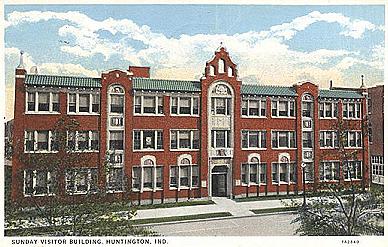 Skipping our
college
classes, we drove day and night arriving in Huntington, Indiana the
next day at 15 minutes to 12 noon. Quickly we changed into our black
suits at a service station where we learned the location of the
publishing house. We arrived there as the town bell was tolling noon
and the workers were leaving the building―about the size of the R H.
(Review and Herald). We attempted to enter but were stopped by the
doorman who informed us that no more visitors were permitted for they
were closing for the week-end. However, we insisted saying we were
seminarians and had come a long distance from Washington, D.C. and
surely there must be someone to receive us. The security guard left us
and returned with the secretary to the editor who invited us inside
locking the door after all the employees had left. (It was providential
that she should be the one to receive us under such circumstances.)
Skipping our
college
classes, we drove day and night arriving in Huntington, Indiana the
next day at 15 minutes to 12 noon. Quickly we changed into our black
suits at a service station where we learned the location of the
publishing house. We arrived there as the town bell was tolling noon
and the workers were leaving the building―about the size of the R H.
(Review and Herald). We attempted to enter but were stopped by the
doorman who informed us that no more visitors were permitted for they
were closing for the week-end. However, we insisted saying we were
seminarians and had come a long distance from Washington, D.C. and
surely there must be someone to receive us. The security guard left us
and returned with the secretary to the editor who invited us inside
locking the door after all the employees had left. (It was providential
that she should be the one to receive us under such circumstances.)
Taking us to her office, she took special note that we were both Latinos with black suits. She said: "I was told by the doorman you were seminarians from Washington, D.C. Rarely do we have such visitors. I have a sister that teaches at Catholic University at the Capital. Which seminary do you attend?" We were hard-pressed for a satisfactory answer; but a quick prayer caused us to reply: "You know the location of the Atonement Seminary at C. U.? Our seminary is right around the corner and over the hill." (Takoma Park). She seemed delighted to escort us all through the publishing house. Returning to her office she seemed to question who we were. She asked: "Incidentally, you are Catholics, are you not?" turning to my buddy, I said: "She asked us if we are Catholics. Just look at us. Catholicism is the common faith of Latin people. My family and relatives have been Catholics for many centuries." (which is true) Quickly changing the subject, I asked her the strangest question: "What has been the most memorable experience in your life?" With a gleam in her eyes, she said: "When I was a young child, Cardinal Gibbons―the first American Cardinal―visited our home in Baltimore and took me on his lap and my yellow locks got caught in the crucifix hanging from his neck. My hair was so tangled my mother had to cut them and I have kept them as a precious memory of the Cardinal." Turning to me she questioned: "Now, what is your most special experience?" For a moment I was at a loss to reply, then all of a sudden I remembered my visit to the Papal Legation in Washington and now I had the answer: "My special experience was a visit to the same chapel in the Papal Legation in Washington, D.C. where the "Holy Father" had his private devotions when he visited America as the Papal Secretary of State." This assured her and from then on she appeared to be completely relaxed.
Finally she asked, "Is there anything more you would like to see?" I said, "Yes, we'd like to see the very first issue of Our Sunday Visitor." She said, "This is a unique request for it so happens we have the only complete file of this paper in all the world, and you came to the right place to see it. Our back files are locked upstairs in the editor's private library for safe keeping. He's not here; but I have the key, so follow me." There she showed us the first issue of the paper published in 1912 [May 5th], bound in yearly volumes. Next, we requested to see the book of 1915 (in which [April 18, 1915.] was published the material regarding Vicarius Filii Dei). To our utter dismay the 1915 book was missing. Then she told us she remembered that because of certain unfortunate past experiences regarding certain issues in 1915, that particular volume was kept in the private safe downstairs in the editor's office. "However, the editor [John F. Noll] is out of town and I happen to know the safe combination, so if you will excuse me, I'll get the 1915 volume." Soon she returned with that particular volume―the special object of our visit.
Then a strange thing happened. She informed us that the editor was a bit unorganized and if we'd excuse her for a few minutes she was going to straighten out the documents in the safe. That providential act gave us just the very opportunity for which we came. Quickly and carefully we checked and found the original issue and confirmed its statement regarding Vicarius Filii Dei and even had time to go through several following issues and verify that there was no subsequent denial by the editor. The Catholics strongly deny that the present tiara of the Pope has any inscription; but they never have denied that the Pope has the title of Vicarius Filii Dei. [Denials appeared in the September 16, 1917 and August 3, 1941 issues. However, even today Catholic apologists will admit that Vicarius Filii Dei is "theologically accurate", but at the same time they deny that it is an "official" title. See: VICARIUS FILII DEI and 666.]
After we saw the original statements, we thought our work was completed; but how mistaken we were; for soon she returned with several loose early copies of Our Sunday Visitor complaining the editor's safe was not well organized and so she straightened it all out and was returning the loose copies to the library. As she approached us with the rare copies in her arms, I noticed that the top paper was the very one with the valuable quotation. My prayerful reaction: "Lord help get this paper for my church." Reaching out I requested to see one of those early precious papers and picked up the top issue. Then something unusual happened. As I looked at the printing at the top of the paper, wishing I had it as my own, I noticed that it was published on April 18, 1915―the day I was born. What a surprise! Calling this to her attention, I said, "Miss Cavanaugh, I have a special request: because of this remarkable coincidence, I'm asking you to give this particular paper to me as an unforgettable treasured souvenir of my visit here." With blushing face, she reminded me this was the only extra copy in all the world; but I told her she would never know how much it meant to me and after all we had come a long way for this visit. Taking the paper from my hand, she replied: "Since this issue was published on the day you were born, I cannot deny such a request." Taking her pen she wrote on the top of the paper: "Happy birthday greetings" and after signing her name, Mary Helen Cavanaugh, she returned the paper to me. In the meantime, while all this was taking place, my alert colleague was going through the rest of the special stack of papers and found the two following issues which she generously gave him upon his request. After thanking her for her unusual kindness, we left.
We deeply felt then and still believe to this day that only the special blessing and guidance of God could have made such success possible and give Him all the glory. The contributing factors: we were both enthusiastic Latinos, both young seminarians, both had staunch Catholic backgrounds, both dressed in black, both loved and leaned heavily on the Lord, and the unique coincidence of my birthday was the date of publication of the important issue which stated Vicarius Filii Dei was the title of the Pope.
Returning to Takoma Park, we went directly to the General Conference and reported to the special committee giving them the copies, saying: "God gave these to us so that we can give them to you." When it was verified that we returned with the only extra original copy of Our Sunday Visitor as well as two of the following issues proving there was no denial of the Pope's title of Vicarius Filii Dei, the brethren asked, "How was it possible to get these valuable issues?" We indicated that it was not us but God who was with us and whose blessing made it possible.
Catholic University of America
As a consequence of this, the
committee
assigned Elders Yost [Dr. Frank R. Yost, Professor of Church History,
Adventist Theological Seminary, Washington D.C.] and Andreasen [Milian
Lauritz Andreasen (1876–1962), field secretary of the General
Conference (1941 - 1950)] as our mentors to advise and direct us to see
if something else could be turned up at Catholic
University. They indicated it might take six months or a year,
but to follow the leadings of the Lord. The very first day [Nov. 14?,
1942] we went to
C. U. dressed in our black suits as seminarians, we were astonished at
the reception we received. The professors tipped their hats to us in
respect to our sacred calling. We were not accustomed to such
treatment. As we approached the library desk, the man in charge stood
up as if seeing a ghost. Coming up to me and throwing his arms a round
me he stated: "Patricio, patricio." (Portuguese for "countrymen,
countrymen"). We had not yet said a word and here we were received in
this fashion. As he gave us his card he said: "I'm Dr. Cardozo,
if you ever need any assistance, please call on me." We could hardly
believe that we would have such a unique reception within 15 minutes
after we arrived at C. U.. I responded that sometime at his convenience
we would like him to introduce us to their specialist on canon law. Dr.
Cardozo indicated that this was a simple request. 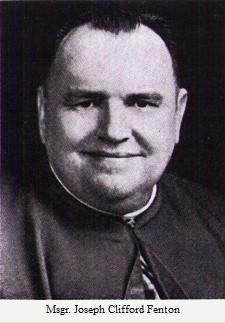 Reaching for the
phone, he made arrangements then and there for us to go to the office
of Dr. Fenton. [Monsignor Joseph
Clifford Fenton
(1906-1969) became editor of
The American Ecclesiastical Review (1944-1966) and is
considered one of most eminent theologians of the 20th Century.] When
we arrived at Fenton's office, we told him that we were seminarians
writing a special research paper on the "Holy Father" and wished to
verify if possible one of his titles which was Vicarius Filii Dei. [The Fenton document] Dr.
Fenton, at that point, phoned the office of the Rector of the
University, transmitting our request. Mgr. [Francesco Giuseppe] Lardone
informed Dr. Fenton that this was a very special matter which he must
take up with the Papal Legation and requested us to return the next day
for an answer.
Reaching for the
phone, he made arrangements then and there for us to go to the office
of Dr. Fenton. [Monsignor Joseph
Clifford Fenton
(1906-1969) became editor of
The American Ecclesiastical Review (1944-1966) and is
considered one of most eminent theologians of the 20th Century.] When
we arrived at Fenton's office, we told him that we were seminarians
writing a special research paper on the "Holy Father" and wished to
verify if possible one of his titles which was Vicarius Filii Dei. [The Fenton document] Dr.
Fenton, at that point, phoned the office of the Rector of the
University, transmitting our request. Mgr. [Francesco Giuseppe] Lardone
informed Dr. Fenton that this was a very special matter which he must
take up with the Papal Legation and requested us to return the next day
for an answer.
We returned to our advisers at the General Conference who, upon learning of all these rapid developments and checking the men we had contacted at Catholic University, were very concerned, for all of them were Jesuits and they counseled us to use extreme caution. They said they would be praying for us as we continued our C. U. contacts. The next day, when we returned to Dr. Fenton's office, we were told to deal directly with the Rector's office, where we were given an envelope stating that they had carefully checked and found no source mentioning Vicarius Filii Dei as a title of the "Holy Father." However, they requested that if we found this title in any Catholic source, they would be willing to give us an appraisal of such.
After several weeks, our G. C. mentors made up a packet of documents and told us to notify C. U. that we had documents for their appraisal which contained the title Vicarius Filii Dei. One Friday afternoon [March 5, 1943] I was mopping the floor at the college cafeteria when the phone rang which I answered. I was told that the Rector's office was calling from C. U. advising me that Monsignor Lardone was ready to appraise our documents. I immediately phoned my colleague, Conrad, who was teaching a Portuguese language class of army officers in downtown Washington. He replied that he couldn't come because it was against the rules to cancel his class and suggested that I contact the GC to sent someone in his place. They chose Elder Mondics to accompany me. I told him to dress in black and remove all identification, because we were dealing with Jesuits.
Arriving at the office of the
Rector, we were
ushered into the presence of the Monsignor. It almost seemed we were
standing before Satan himself. Before us was a strange, bent-over man,
whose beady eyes seemed to penetrate within. Silently he stared at us
for a long 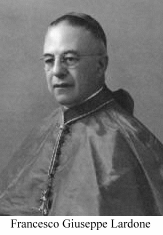 time as if wondering
who we were and what was our objective.
Formerly, he was the editor of the Vatican newspaper and now he was in
a very responsible position at Catholic University. After carefully
checking our documents, he commented first on the Moroni document,
saying he had used it in his classes and was unaware that it mentioned
the Pope's title, Vicarius Filii Dei. He translated this Italian
document* and said its reference to the Pope's title was vague.
time as if wondering
who we were and what was our objective.
Formerly, he was the editor of the Vatican newspaper and now he was in
a very responsible position at Catholic University. After carefully
checking our documents, he commented first on the Moroni document,
saying he had used it in his classes and was unaware that it mentioned
the Pope's title, Vicarius Filii Dei. He translated this Italian
document* and said its reference to the Pope's title was vague.
*Dizionario di erudizione storico-ecclesiastica da S. Pietro sino ai nostri giorni (Dictionary of Historical-Ecclesiastical Erudition from St. Peter to the Present), by Gaetano Moroni, 103 volumes and 6 volumes of indexes printed in Venice by Tipografia Emiliana between 1840 and 1861. The title appears in volume 99, page 21, in the entry for VICARIO DI GESU' CRISTO [Vicar of Jesus Christ], where it states very briefly that the inscription Vicarius Filii Dei is to be found in the Vatican. [ Vol. 99 title page - Vol. 99 pg. 21, GIF format ]
Then picking up the Gratian document,± he said it was our best source and he referred us to Dr. [Johannes] Quasten [1900-1987] who was their greatest authority in this field [he was a renowned patristics scholar]. Leaving Mgr. Lardone, we went directly to the office of Dr. Quasten. He informed us that Gratian was used and accepted for many centuries as a legitimate Catholic source, but in recent years, his work is considered by most scholars as non-authentic.
± Concordantia discordantium canonum (Concordance of Discordant Canons), also known as Decretum Gratiani or Corpus Juris Canonici, a collection of canon law published about 1140 A.D. by Johannes Gratian. The Bavarian State Library of Germany has a digitized 1879 version of
Corpus Iuris Canonici available online, with full document download in .pdf format. The title appears in a quote of the Donation of Constantine in column 342 (image 223). The relevant section is found under the following headings: - CONCORDIA DISCORDANTIUM CANONUM AC PRIMUM DE IURE NATURAE ET CONSTITUTIONIS
- DISTINCTIO XCVI.
- C. XIV. De eodem.
Dr. Yost had previously briefed
us on all these
documents and at his suggestion, we said to Dr. Quasten: "Putting all
documents aside, do you as a recognized Catholic authority accept the
title Vicarius Filii Dei as a proper and legitimate title of the "Holy
Father?" At that point, Dr. Quasten asked me, "Why do you question me
about this title of the Pope?" I was on the spot, not knowing how to
respond. Suddenly I remembered that in the Catholic system (not always
in ours) great respect is shown to superiors. 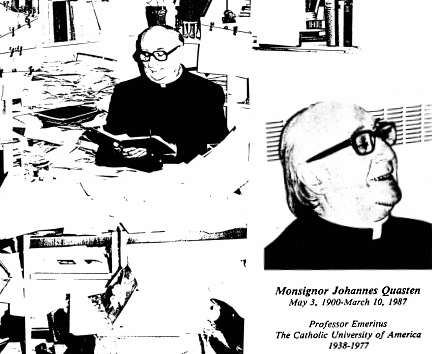 Now, I had the answer to his
question by
saying that we had just come from the office of his superior who had
sent us to him for his appraisal. (In other words, we, not he, were
authorized by his superior to ask the questions.) He got the point, and
obviously was a bit embarrassed since he had dared to question us. In a
submissive attitude, Dr. Quasten acknowledged, "The Pope has many
titles. Although Vicarius Filii Dei is not as common, it is, however,
an ancient title and should be accepted by any good Catholic scholar."
Suddenly I realized that his excellent testimony was insufficient
because it was only verbal. Speaking to him, I said, "Dr. Quasten, I
have a friend who has been working on this project who could not be
here today. We accept your appraisal but for the sake of my colleague,
would you be kind enough to write a simple statement that this is a
recognized and accepted title?" Dr. Quasten, questioned, "Is this
necessary? I responded, "If this is a legitimate title, why not admit
it in writing?" Instead of using his typewriter, Dr. Quasten pulled out
his pen and in his own handwriting wrote on official Catholic
University stationary the following: "The title Vicarius Filii Dei
as well as the title Vicarius Christi is very common as the
title for the Pope." and signed his name. [The
Quasten document]
Now, I had the answer to his
question by
saying that we had just come from the office of his superior who had
sent us to him for his appraisal. (In other words, we, not he, were
authorized by his superior to ask the questions.) He got the point, and
obviously was a bit embarrassed since he had dared to question us. In a
submissive attitude, Dr. Quasten acknowledged, "The Pope has many
titles. Although Vicarius Filii Dei is not as common, it is, however,
an ancient title and should be accepted by any good Catholic scholar."
Suddenly I realized that his excellent testimony was insufficient
because it was only verbal. Speaking to him, I said, "Dr. Quasten, I
have a friend who has been working on this project who could not be
here today. We accept your appraisal but for the sake of my colleague,
would you be kind enough to write a simple statement that this is a
recognized and accepted title?" Dr. Quasten, questioned, "Is this
necessary? I responded, "If this is a legitimate title, why not admit
it in writing?" Instead of using his typewriter, Dr. Quasten pulled out
his pen and in his own handwriting wrote on official Catholic
University stationary the following: "The title Vicarius Filii Dei
as well as the title Vicarius Christi is very common as the
title for the Pope." and signed his name. [The
Quasten document]
When we returned with his signed statement to the General Conference, they could hardly believe what had happened. They asked us, "How in the world did you get this?" We replied, "Don't give us any credit, the Lord gave it to us for our church." Then they reminded us that we had been dealing with the Jesuits and forbade us to ever return to Catholic University; that our part was completed. Calling in a lawyer and a notary, a statement of our witnessing the Quasten's statement and signature was added to the bottom of the page making it a legal deposition which was given to the General Conference for safe-keeping. Several days later we were called before the full G. C. Committee and given a personal commendation by Elder McElhany―president of the General Conference.
Preceding the coming of Christ, there will be an unmasking of the "Man of Sin" who is identified by a number which is the number of a man and the number of his name. We are thankful to God that we had a small part in the verification of that name whose Latin letters make up that number and that our preachers and publications are no longer inhibited in their proclamation of this important part of our message.
OFFICIAL USE OF VICARIUS FILII DEI BY A
POPE HAS BEEN FOUND,
AS WELL AS APPLICATION TO THE POPE BY A 14TH CENTURY CANON LAWYER!
See: 666, The Number of the Beast.
VICARIUS FILII DEI and 666 - Response to a Challenge by Patrick Madrid of Envoy Magazine.
Correcting Samuele Bacchiocchi's Newsletters on 666
